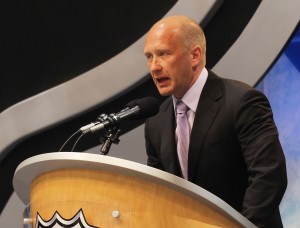 Coming into the trade deadline, Hockey Operations President John Davidson and General Manger Jarmo Kekäläinen warned that there would be no short term deals — no rentals — forthcoming at the deadline. It was widely reported that the club was dangling one of its three first round picks in an effort to bolster offense, but the non-rental market for goal scorers appeared speculative, at best. Sure, there was the possibility that pending RFA goaltender Steve Mason might be moved for a pick, but the likelihood of any true hockey trades being made seemed remote. This was particularly true in light of the purges put in place by the likes of Calgary and Dallas over the past few days. It was entirely likely that Wednesday would come and go with no significant deals for the Blue Jackets — or anyone else for that matter.
Coming into the trade deadline, Hockey Operations President John Davidson and General Manger Jarmo Kekäläinen warned that there would be no short term deals — no rentals — forthcoming at the deadline. It was widely reported that the club was dangling one of its three first round picks in an effort to bolster offense, but the non-rental market for goal scorers appeared speculative, at best. Sure, there was the possibility that pending RFA goaltender Steve Mason might be moved for a pick, but the likelihood of any true hockey trades being made seemed remote. This was particularly true in light of the purges put in place by the likes of Calgary and Dallas over the past few days. It was entirely likely that Wednesday would come and go with no significant deals for the Blue Jackets — or anyone else for that matter.
As the day dawned, it seem that the predictions of a bleak trading landscape would come to fruition. Hours passed with no activity. Zip . . . Nada . . . Zilch. At 11:45 EDT, news “broke” that Blue Jackets defenseman Jack Johnson had left practice early, and the vultures descended. Adhering to my general rule that “If TSN is not reporting it, it hasn’t happened”, I disregarded it, and it was not long before Lori Schmidt debunked the building hysteria by airing the club statements that Johnson was a bit banged up and was consulting the training staff. While devoted conspiracy theorists held fast to the idea that Johnson was leaving, and Twitter false prophets resurrected the Johnson-to-Pittsburgh scenario, order was soon restored . . .as was inertia. As the clock passed 2:00 PM, resignation began to set in that nothing of significance was going to happen. Then, at about 2:25, all hell broke loose. In a span of 35 minutes, the Blue Jackets became the talk of the hockey world.
While more detailed analysis will be forthcoming in the days ahead, here is my current take on the deals — in the order they came to light:
Groundhog Day: A Goalie Trade with the Flyers
It seems like only yesterday that the Blue Jackets consummated a deal with Philadelphia that sent a passel of low round picks to The City of Brotherly Love for Sergei Bobrovsky. At the time, Paul Holmgren and Flyers fans thought that they had put one over on the rubes in Columbus. Well, not so much, actually. Just take a gander at the goalie statistics – and the standings — and you’ll see why. Apparently figuring that lightning never strikes twice, the Flyers have gone back to the well, sending their current back-up goalie — Michael Leighton — to Columbus, accompanied by a 3rd round pick, in exchange for the beleaguered Steve Mason. Not to say that Philadelphia is in dire strait in goal, but the TSN panel evaluating the deal opined that the Flyers would likely buy out Bryzgalov at season’s end — for tens of millions of dollars — now that Mason was on board. Upon hearing that one, the collective Columbus fan base choked on their adult beverages of choice.
There is no question that Steve Mason has talent — you don’t win the Calder Trophy without it. But to say that he’s struggled since that rookie campaign would be an understatement
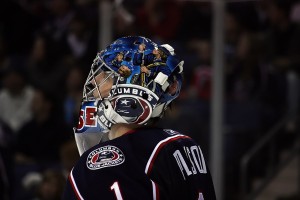
of significant proportions. In that Calder-winning season, Mason was 33-20-7, with a .916 save percentage, a 2.29 GAA and 10 shutouts. Amazing stuff. He was big and smooth in the net, posted bookend 3 – 0 shutouts over Ovechkin and the Capitals, and overcame mononucleosis in the process. However, in the four years since, he is 63-79-2-. with an .899 save percentage and a GAA significantly north of 3.00. Perhaps more problematic than the numbers is the fact that the club plays demonstrably differently with Mason in the net, and he does not project the sense of control and confidence you want and need in the blue ice. He appears to be surprised by the puck far too often, and has yet to master the art of rebound control.To be fair, Mason hasn’t had the best teams in front of him during this interval, and is still young for a goaltender — facing his 25th birthday next month. But with the arrival of Bobrovsky — a maligned backup in Philadelphia — the situation crystallized this season. Playing behind the same squad, Bobrovsky has excelled, while Mason is mired in mediocrity. In the last year of his deal, Mason is an RFA at season’s end. In the unlikely event that a team would drop an offer sheet on Mason, the club would get a 2nd round pick in compensation. Parlaying that into a player and a pick is a victory, and much bigger return than could have been realistically anticipated. Certainly, Leighton has had his own issues, appearing in just a single game for the Flyers this year, and promptly surrendering five goals. However, he posted good numbers in the AHL over the past two seasons, and knows the backup role. This is the essential difference in the deal — Columbus is looking for a servicable backup, while the Flyers seek a potential option to Bryzgalov. I’m much better with Leighton as the backup than Mason as the starter. Columbus wins this deal.
Groundhog Day II — A Roster Swap with the Rangers
The NHL pundits were still expounding on the Life & Times of Steve Mason when the real hammer fell — a multi-player shocker with the Rangers that sent Derick Brassard, Derek Dorsett, John Moore and a 6th round pick to The Big Apple in exchange for Marian Gaborik and minor league defensemen Steven Delisle and Blake Parlett. The sound of jaws hitting desks was deafening, as Columbus made a bold move to shore up their scoring, which ranks 29th in the league, ahead of only . . . the Rangers. It’s a deal that has a number of fascinating sub-plots, but we’ll touch on just a few.
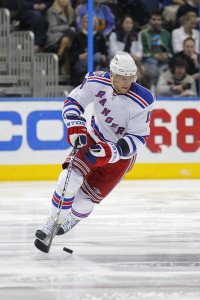
First, from the Columbus side, getting an elite scorer of Gaborik’s caliber is a coup, particularly at the trade deadline, when true hockey deals are few and far between in the salary cap era. Gaborik has the slightly spooky statistical line of 333 goals & 333 assists for 666 points in 757 NHL contests. He has seven 30+ goal seasons, including three over 40, and has reached the 80 point mark twice. (For comparison purposes, Nash has 302-275-577 in 706 contests, and has never broken the 80 point barrier). Gaborik brings an up-tempo style of play, and a lethal scoring potential. He has struggled this year, but posted big numbers last season. At 31, he is a veteran player, but should have several productive years remaining. Despite Tortorella’s protestations to the contrary, Gaborik was clearly not a favorite, and has appeared to be pressing much of this season, as he has been shifted from line to line. He carries a relatively healthy $7.5 million cap hit for one more season, but that is not an issue under the existing salary structure in Columbus, particularly since $5.8 million went in the other direction. While there is an injury history with Gaborik, it does not appear to be a present concern. Kekäläinen has already indicated that the club is looking to sign Gaborik to a contract extension, true to the professed avoidance of short term deals. The minor league players involved in the deal are of interest primarily because Delisle returns to Columbus after having been part of the Nash trade last year.On the other side of the coin, the Blue Jackets lose some roster players – and two former first round picks. The movement of Brassard potentially raises the most issues, as he has been an enigmatic contributor since the 2006 draft. Terrifically skilled, and the best pure passer on the team, Brassard’s talent and work ethic have not always aligned, resulting in friction with the last three Blue Jackets coaches — Hitchcock, Arniel & Richards. Again, while Richards will deny it, Brass was not among his favorites, likely due to his penchant for the “pretty” play, rather than the direct shot. He was inconsistent in the face-off circle, making him difficult to slot. He didn’t shoot often enough to be set on the wing, but his face-off issues impacted his efficacy at center. With the spectre of Nash removed, the organization was clearly looking for Brassard to take offensive control this year, and that simply has not happened. He has played well, but has not assumed the pre-eminent role you would expect for a draft pick of his stature. After seven years, and faced wth the chance to get Gaborik, the Blue Jackets decided that they could not wait any longer for his development, and made him part of the deal.
The demise of John Moore as an organizational asset has been somewhat of a surprise. Moore showed some real progress last season, and clearly beat out David Savard for a role on the big club this year. Never an offensive threat, Moore is an excellent skater, with some puck moving ability. He has speed, but lacks the muscle to consistently drive players off the puck. With the emergence of Dalton Prout and the arrival of Tim Erixon, Moore’s role appeared to diminish. There is something about Moore’s game that Richards apparently did not like, as in recent weeks Moore was scratched in favor of the experienced, but slower, Adrian Aucoin — even when Moore’s speed would have been an asset. However, with Prout and Erixon on the scene, and Ryan Murray and Cody Goloubef in the wings, Moore’s value was not what it once was.
The inclusion of Derek Dorsett in the deal will likely be the most polarizing aspect of the trade in terms of the fan base. There really is very little middle ground when it comes to

Dorsett , as some fans place him as the “heart & soul” of the Blue Jackets, while others see a guy with a relatively large contract for his numbers, limited skill, and a propensity to make an ill-conceived play at the wrong time. While I fall mostly in the latter category, I have always admired Dorsett’s energy and effort — at least in the offensive zone. If it moved, he hit it, and he caused enough turmoil to bring about some scoring chances. In past seasons, where effort was an issue on the squad, this was a vital quality. As the team has transformed, however, it has become less essential, as effort has been consistent and any number of players are demonstrating fire — with much more skill. While his on-ice thinking has improved, he still is prone to taking the brain-dead penalty and his scrappiness too often degrades to thuggery — a fact that has not escaped the attention of NHL officials. He will never get the benefit of a call.Dorsett is out for the balance of the regular season, and is slated to earn $3.4 million over the next two season. For comparison, Mark Letestu just signed a new 2 year deal for a total of $2.5 million, and brings far more skill and point production to the table. Thus, while the emotional side of the deal would urge against the trade, hockey is a business, and the business case is solid. The Blue Jackets are becoming a top-flight organization, and every roster player needs to contribute more than just guts and effort. Those are assumed now, and the pressure is on to perform.
So, who wins this deal? Likely too early to tell, though New Yorkers are ecstatic after Brassard notched four points (1 power play goal and 3 assists) in his MSG debut last night, and John Moore added a goal of his own in a 6- 1 thrashing of the Penguins. Frankly, the Penguins looked awful, and Moore and Brassard were riding the adrenaline of the moment. Only time will tell how the new setting will balance out with the pressure of the New York media and the pugnacious Rangers coach. But I think the major metric is how the deal addressed the organizational goals. For Columbus, the clear goal was to improve scoring. On paper, this goal was met. Gaborik’s probable production exceeds the sum total of the departing players combined, at a net cap hit that makes sense. The realistic probability that Gaborik will notch 70 or 80 points is significantly higher than the likelihood that Brassard-Moore and Dorsett will do the same.
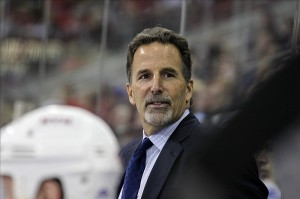
The Rangers’ goals are a bit murkier, as they undoubtedly included improved scoring, cap clearance and adding defensive depth. Moore meets the latter goal, and they got some cap room, but not a lot. Whether the move improves their scoring over the long terms is a more problematic question. It’s fair to say that both teams took on some risk and stand to reap some rewards, so it’s likely a good deal both ways. Brassard, Moore and Dorsett join Nash and Stralman in the Manhattan chapter of the Blue Jackets Alumni Association, while Gaborik adds to the Columbus contingent of former Rangers, including Erixon, Dubinsky, Anisimov and Tyutin. Maybe the best way to evaluate the deal in the short term is to judge whether you’d trade Nash, Brassard, Dorsett and Moore for Dubinsky, Anisimov, Erixon, Gaborik and a 1st round draft pick. If I’m the Columbus Blue Jackets, I make that deal every day.
The Sleeper Deal: Comeau Comes from Calgary
While the Blue Jackets also acquired ECHL goalie Patrick Killeen from the Pengiuins for future considerations, the other significant move involved the acquisition of forward Blake Comeau from the Flames for a 2013 5th round pick. In the Scott Howson days, we would have referred to this as a potential Roster Ninja pick. Comeau brings size and skill to the table, but has struggled in his two seasons in Calgary. However, he is not alone in that regard, so that fact alone should not be determinative in looking at his potential contributions. Comeau just turned 27, and posted consecutive 40+ point seasons for the Islanders in the 09-10 and 10-11 seasons. He commands a reasonable $1.25 million salary, and as a UFA at the end of the year, has significant motivation to show his stuff.
Comeau is the “wild card” of the day’s events. If he returns to the 40 point level — or anything reasonably close to it — this one will qualify as an absolute steal. With only a 5th round pick in the game, this is a move with little downside and a big upside potential. Here’s an interesting take on the winger. Buy low, sell high. Kekäläinen seems to get it.
As The Dust Settles . . .
Aside from the obviously stunning nature of the moves yesterday, there were a couple of surprises in terms of things that were not done. I expected Aucoin to move, but he didn’t. In
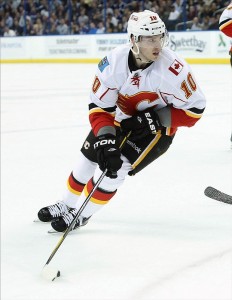
light of Moore moving on, the organization undoubtedly wanted some experienced depth on the blue line down the stretch. Moore’s trade also pre-empted another move I expected, which was the departure of David Savard. However, absent another deal to which he could contributed, it was likely deemed better to keep the depth at the position in Springfield, with a veiw toward the next trading horizon in June.At the end of the day, the Blue Jackets’ profile had undergone a significant change, but likely not to the extent of being disruptive. Most knew in their hearts that Mason was going. Moore had been marginalized in recent weeks, and Dorsett was out for the year. So, does the excitement over the arrivals of Gaborik, Comeau and Leighton overcome the loss of Brassard? Undoubtedly. When all is said and done, Columbus now has a top nine — in no particular order — of Anisimov, Dubinsky, Foligno, Johansen, Prospal, Calvert, Atkinson, Umberger and Comeau. Not bad. With Boone Jenner waiting in the wings, the offense is suddenly looking potent.
What is perhaps most remarkable is that all of this was done, while the club still retains its three first round picks. While the playoff run will be undeniably entertaining, whether or not that task is fulfilled, the organization has taken massive strides, and is poised to do more come the off-season. With the impending move to the Eastern Conference, the positive attention of the entire NHL and the virtual certainty of an All-Star game within the next 24 months, this is becoming a resurgence of epic proportions. Quite a debut for Mr. Kekäläinen. While the plan may be “brick by brick”, this has more the feeling of an entire wall.